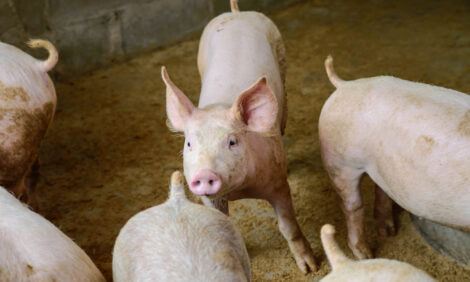|
Need a Product or service?
|
|
Purdue News
|
Breeding herd sizes in leading hog producing states, including Indiana,
are smaller than one year ago. That portends rising prices this year
and in 2004, said Chris Hurt, a Purdue University agricultural
economist.
Prices could approach the mid-$40 range per live hundredweight by next
spring, Hurt said. If so, producers would enjoy their most profitable
period in three years.
"We're looking for a profitable year through the rest of 2003 and
throughout most of 2004," Hurt said. "The reduction of the breeding
herd that's occurring has the supply of pork coming down, giving us
prospects for better prices."
The nation's breeding herd stood at 5.94 million head on June 1, down 4
percent from June 2002, according to a U.S. Department of Agriculture
report. Midwest pork producers made even greater herd cuts, Hurt said.
"Missouri was at the top of the list, down 11 percent from one year
earlier," he said. "Iowa, a huge hog state, was down 8 percent. Ohio
also was off 8 percent. Illinois was down 7 percent on its breeding
herd, Indiana down 6 percent and Nebraska down 5 percent."
Indiana's breeding herd totaled 310,000 in June, according to the
Indiana Agricultural Statistics Service. Total sows farrowed were
140,000 in the March to May 2003 quarter, down 10 percent from the same
quarter in 2002.
The massive herd liquidation comes on the heels of industry losses from
March 2002 through April 2003. During that 14-month stretch, average
estimated loss per head was $12, driving some small- and moderate-size
hog producers out of business.
Not far back in producers' memories is 1998-99, when live weight bids
plunged below $10 a hundredweight. At its worst point, producers lost
in excess of $60 per hog.
Currently, hog prices hover in the low $40s. Production costs per
hundredweight are near $40.
The next 18 months should provide producers much-needed economic
stability, Hurt said.
"The cost structure is going to come down about $2 a hundredweight this
fall," Hurt said. "We think we'll see lower grain prices, lower soybean
meal prices and very moderate interest rates.
"We're anticipating hog prices to average in the low $40s per
hundredweight this summer. Fall and early winter prices probably will
be in the very high $30s. We think that's going to be very close to at
least break-even levels, covering all costs. Pushing into the spring
and summer of 2004, we're looking for hog prices to be back in the low
$40s and probably move toward the mid $40s."
A rebounding U.S. and world economy and weaker U.S. dollar also benefit
pork producers, Hurt said.
"Another positive for hog prices is that we're seeing more signs of
economic recovery," he said. "That is going to help fuel the demand for
pork. We also have seen the exchange rate of the U.S. dollar relative
to the Canadian dollar come down. That's a positive factor, in that
there will be less incentive for Canadian producers to push hogs to the
United States to be fed and processed."
The export of Canadian pigs to the U.S. is up 5 percent this year, with
6 percent of all hogs slaughtered in the United States coming from
Canada.
Hurt believes long-term prospects for hog producers could continue
looking up, as the industry becomes leaner and more competitive.
"I think there's been a lot of hesitancy about being in the hog
business," he said. "There are many concerns about the very narrow
profit margins, environmental issues and the negative press the
industry has received. Over the next few years, there may be hesitancy
among pork producers to expand their operations and for corporations to
get into the business.
"My guess is that in the next five years the margins in the hog
business are going to be better than the dismal margins producers have
endured the last five years."
Source: Purdue News Service, Chris Hurt - 18th July 2003

















